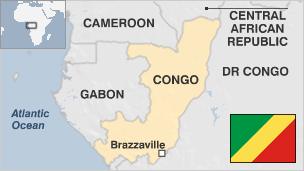-
4 February 2015
- From the section Africa

Civil wars and militia conflicts have plagued the Republic of Congo, which is sometimes referred to as Congo-Brazzaville.
After three coup-ridden but relatively peaceful decades of independence, the former French colony experienced the first of two destructive bouts of fighting when disputed parliamentary elections in 1993 led to bloody, ethnically-based fighting between pro-government forces and the opposition.
A ceasefire and the inclusion of some opposition members in the government helped to restore peace.
Civil war
But in 1997 ethnic and political tensions exploded into a full-scale civil war, fuelled in part by the prize of the country’s offshore oil wealth, which motivated many of the warlords.
The army split along ethnic lines, with most northern officers joining President Denis Sassou Nguesso’s side, and most southerners backing the rebels. These were supporters of the former president, Pascal Lissouba, and his prime minister, Bernard Kolelas, who had been deposed by President Sassou Nguesso in 1997.
By the end of 1999 the rebels had lost all their key positions to the government forces, who were backed by Angolan troops. The rebels then agreed to a ceasefire.
Remnants of the civil war militias, known as Ninjas, are still active in the southern Pool region. Most of them have yet to disarm and many have turned to banditry.
Oil and diamonds
The Republic of Congo is one of sub-Saharan Africa’s main oil producers. Oil is the mainstay of the economy and in recent years the country has tried to increase financial transparency in the sector.
According to the World Bank, nearly half the population still lives in poverty, though high levels of extreme poverty have declined significantly over recent years.
China has become a major source of financing for Congo’s infrastructure and the Congolese authorities have implemented an ambitious investment programme in the areas of transport and energy.
In 2004 the country was expelled from the Kimberley Process that is supposed to prevent conflict diamonds from entering the world supply market. This followed investigations which found that the Republic of Congo could not account for the origin of large quantities of rough diamonds that it was officially exporting.
In 2010, the IMF and World Bank approved debt relief for the Republic of Congo of $1.9 billion, reducing its debt burden by 34 per cent in an effort to free up resources to support growth and social policies.


